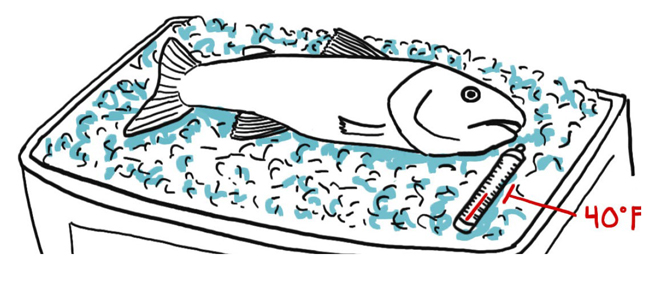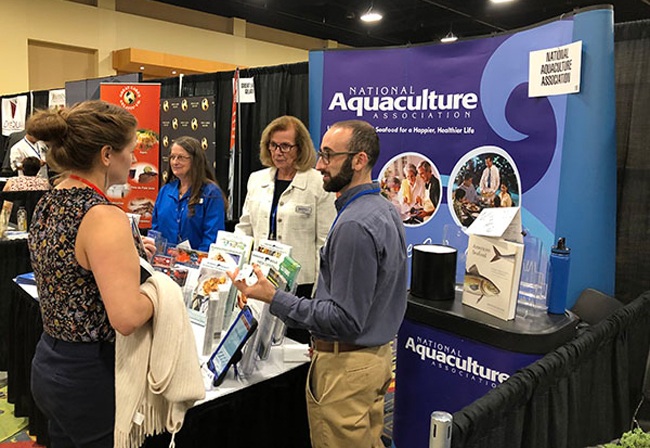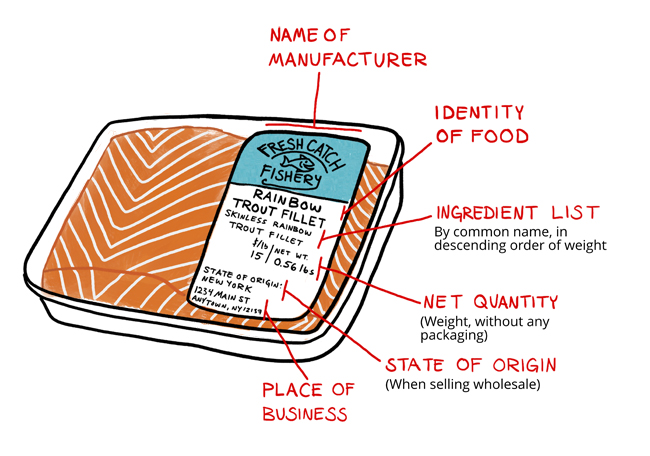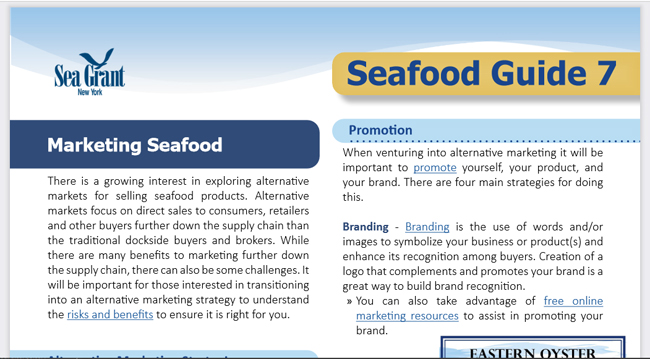
Temperature controls to ensure fish/shellfish is cooled quickly and maintained at an internal temperature below 40 degrees F until cooked and/or consumed. Credit: NYSG. Illustration by Georg Pedersen, from Seafood Guide 2: Enhancing Seafood Safety and Marketability
— By Chris Gonzales, Freelance Science Writer, New York Sea Grant
Contact:
Michael Ciaramella, NYSG Seafood Safety & Technology Specialist, E: mc2544@cornell.edu, P: 631-632-8730
Stony Brook, March 22, 2023 - The COVID-19 pandemic may have forced many consumers to avoid restaurants and exclusively shop retail for food. Yet even as restrictions ease, says specialty website SeafoodSource, consumers are likely to continue buying more seafood from retail.
As the seafood marketplace shifts, New York Sea Grant (NYSG) has been working with partners across New York State and the nation to support US seafood production and consumption.
“It is important for producers to adapt to changing seafood markets and build resilience to future changes,” said Michael Ciaramella, a seafood safety and technology specialist with NYSG. “We are working to develop tools and resources to help our New York producers build this resilience and enhance their ability to continue to adapt and change over time.”
Making the most of it
NYSG, in collaboration with the National Aquaculture Association (NAA), has developed resources to help chefs—and budding entrepreneurs—better understand and take advantage of locally-farmed seafood.
Project leaders Ciaramella and Linda O’Dierno (NAA) see a need for a workforce that is knowledgeable about local seafood and current trends in the direct-to-consumer retail marketplace.

Project leaders Mike Ciaramella (at far right) and Linda O’Dierno (behind the table, at right) interact with a participant at an American Culinary Federation conference. Credit: Michael Ciaramella/NYSG
In 2020, during the height of pandemic restrictions in the US, grocery stores found the seafood department was a leading driver of increased sales. In total, seafood generated more than $16.6 billion in sales for food retailers in 2020. (These data appeared in a 2021 report by the Food Industry Association.)
Meanwhile, even those consumers who are already comfortable with buying seafood want to become more knowledgeable about preparing it. Thus there’s an opportunity, says the Food Industry Association, for entrepreneurs to provide products such as ready-made kits with instructions for the consumer.
Direct-to-consumer companies such as Wild Alaskan Company have grown rapidly as people have appreciated fresh seafood delivered safely to their doors. Meanwhile, in New York State, you can find businesses marketing direct to consumers. Visit localfish.org to find some of these businesses in New York—particularly on Long Island and in New York City. You can also explore freshfishfinder.org to locate some New York producers outside of Long Island and NYC.
Against this backdrop, Ciaramella and O’Dierno are offering resources and ideas for educators to pass along to future chefs. Topics include recipe writing and creation; safety protocols; gaining experience to make quality meal kits; and marketing through their Culinarian’s Guide to Aquaculture, or Farmed Fish publication.
This aquaculture guide, a product of a NOAA-funded 2018 National Aquaculture Association project, highlights a variety of resources to help you understand U.S. Aquaculture production or farmed fish.
Over the past several years they have hosted aquaculture-centric sessions at a variety of culinary conferences to engage culinary educators and professionals directly. Alongside these efforts they are distributing compiled resources on flash drives.

Clear food labels help consumers know what they’re getting. Credit: Georg Pedersen
Risks with rewards
In addition to authoring the guide for educators, chefs, and professionals, Ciaramella has coordinated a task force of industry, agency and academic professionals to identify ways to support processing and marketing sustainably-caught and -raised seafood in New York.
The pandemic created a market opportunity for producers. However, to get the food to consumers, producers have to understand and follow a number of rules and regulatory requirements.

Seafood Guide, marketing section. Credit: NYSG
New guides are helping people who are getting started in seafood sales and marketing sort out the key details. The guides are designed to help New York fishermen and aquaculturists open up new markets for seafood and seafood products.
Under Ciaramella’s direction, the Seafood Processing and Marketing Task Force authored the guides. The task force is comprised of industry, academic, and government partners representing the fisheries and aquaculture industries.
The guides consolidate many regulatory details in one place. The topics include food labeling, food safety, or HACCP (Hazard Analysis and Critical Control Points), sanitation, and marketing.
The guides are available on the web: www.nyseagrant.org/seafoodguides.
In addition, the Seaweed Processing and Marketing Task Force released a set of guides in the spring of 2022—about marketing and processing seaweed.
Those guides can be found at: www.nyseagrant.org/seaweedguides.
Like the seafood regulatory guide, the 37-page seaweed regulatory guide combines numerous regulatory details in one place.
The project is supported by partnerships between New York Sea Grant and: Empire State Development, New York City Department of Planning, New York City Department of Transportation, New York State Department of Agriculture and Markets, New York State Department of Environmental Conservation, Nassau County Department of Health, Suffolk County Department of Economic Development and Planning, Suffolk County Department of Health Services, Suffolk County Weights and Measures, U.S. Food and Drug Administration, Blue Moon Fish, Cornell Cooperative Extension Suffolk County, Hudson Valley Fisheries, Long Island Commercial Fishing Association, New York Sea Grant, SUNY Morrisville, and Upward Farms.
More Info: New York Sea Grant
New York Sea Grant (NYSG), a cooperative program of Cornell University
and the State University of New York (SUNY), is one of 34 university-based
programs under the National Oceanic and Atmospheric Administration’s
National Sea Grant College Program.
Since 1971, NYSG has represented a statewide network of integrated
research, education and extension services promoting coastal community
economic vitality, environmental sustainability and citizen awareness
and understanding about the State’s marine and Great Lakes resources.
Through NYSG’s efforts, the combined talents of university scientists
and extension specialists help develop and transfer science-based
information to many coastal user groups—businesses and industries,
federal, state and local government decision-makers and agency managers,
educators, the media and the interested public.
The program maintains Great Lakes offices at Cornell University, SUNY
Buffalo, SUNY Oswego and the Wayne County Cooperative Extension office
in Newark. In the State's marine waters, NYSG has offices at Stony Brook
University in Long Island, Brooklyn College and Cornell Cooperative
Extension in NYC and Kingston in the Hudson Valley.
For updates on Sea Grant activities: www.nyseagrant.org has RSS, Facebook, Twitter, Instagram, and YouTube links. NYSG offers a free e-list sign up via www.nyseagrant.org/nycoastlines for its flagship publication, NY Coastlines/Currents, which is published quarterly.